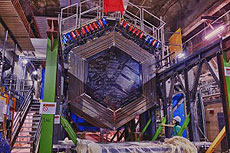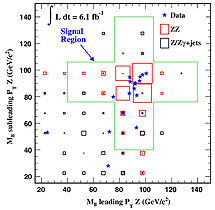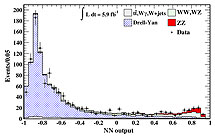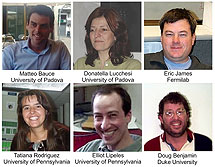|
Have a safe day!
Thursday, March 15
2:30 p.m.
Theoretical Physics Seminar - Curia II
Speaker: Tim Cohen, SLAC National Accelerator Laboratory
Title: Electroweak Baryogenesis and Higgs Signatures
3:30 p.m.
DIRECTOR'S COFFEE BREAK - 2nd Flr X-Over
4 p.m.
Accelerator Physics and Technology Seminar - One West
Speaker: John Corlett, Lawrence Berkeley National Laboratory
Title: Next Generation Light Source R&D and Design Studies at LBNL
Friday, March 16
2 p.m.
Accelerator Controls Seminar - One West
Speaker: Brian Hendricks, Fermilab
Title: Accelerator Command Language (ACL); A Simple Scripting Language
3:30 p.m.
DIRECTOR'S COFFEE BREAK - 2nd Flr X-Over
4 p.m.
Joint Experiment-Theoretical Physics Seminar -
One West
Speakers: Rick Cavanaugh, Fermilab/University of Illinois at Chicago
Title: Highlights from Recent CMS Results
Click here for NALCAL,
a weekly calendar with links to additional information.
Upcoming conferences |
|
Thursday, March 15
- Breakfast: Apple sticks
- Southwestern chicken tortilla
- Philly style cheese steak
- Garlic herbed roasted pork*
- Smart cuisine: Mardi Gras jambalaya
- Southwestern turkey wrap
- Assorted sliced pizza
- Marinated grilled chicken Caesar salads
*carb-restricted alternative
Wilson Hall Cafe Menu
|
|
Friday, March 16
Dinner
Closed
Wednesday, March 21
Lunch
- Parmesan crusted chicken w/ sage butter sauce
- Roasted potatoes w/ garlic & rosemary
- Steamed green beans
- Strawberry cream torte
Chez Leon Menu
Call x3524 to make your reservation. |
|
Scientists send encoded message through rock via neutrino beam
 |
|
Scientists used Fermilab's MINERvA neutrino detector to decode a message in a neutrino beam.
|
Humankind is constantly inventing new ways to stay in touch. But in some situations it's difficult to keep the lines of communication open. A space shuttle's radio falls silent when the craft slips behind a neighboring planet. A submarine loses contact when deep water blocks signals from the surface.
Scientists recently proved possible a new way to converse when radio waves won't do. For the first time, physicists and engineers have successfully transmitted a message using neutrinos.
Scientists have for decades contemplated communicating across long distances in a kind of Morse code via neutrinos, ghostly particles that interact so rarely that they can sail through the entire Earth.
"It's beginning to look more feasible," said electrical engineer Dan Stancil of North Carolina State University, who proposed the recent neutrino communication test as a side experiment at Fermilab's MINERvA neutrino detector.
In the early 1980s, Stancil, who was then at Carnegie Mellon University, was intrigued by the idea of using rarely interacting particles for communication. But he was focused on axions, still undiscovered particles predicted by some theories related to dark matter. In 2009, Carnegie Mellon Ph.D. student Jim Downey contacted Stancil, his former professor, to tell him about MINERvA.
The 170-ton MINERvA detector was designed to study neutrino interactions in unprecedented detail, not to function as the receptor in a neutrino telegraph. But luckily for Stancil, the detector sits close to one of the most intense neutrino beams in the world, and that beam is pulsed. Using just over two hours of beam time, scientists were able to manipulate that pulse to convey a message: the word "neutrino."
Read more
—Kathryn Grim
|
Ringing the neutrinophone
From The Economist, March 14, 2012
On a normal day physicists from the MINERvA collaboration based at Fermilab, America's main particle-physics facilty, near Chicago, study neutrinos in the hope of unlocking the mysteries of the universe. In their spare time, though, they decided to test an idea that is (slightly) more down to Earth. For years theorists have mused that neutrinos' signature unwillingness to interact with matter might be harnessed to dispatch messages directly through the Earth's core, to submerged submarines or even across galaxies, which are impervious to traditional electromagnetic signals. In a paper just submitted to Modern Physics Letters A, MINERvA's boffins demonstrate that such proposals, though wacky, are not completely outlandish.
MINERvA uses a beam of neutrinos sent from Fermilab's accelerator, the Main Injector, to a detector roughly 1km (0.6 miles) away. The beam is created by smashing pulsed bunches of trillions of protons into a graphite target. For a week before the start of a maintenance break, however, it runs at half its typical intensity, not ideal for MINERvA's day job, but just dandy for the communications test.
Read more
|
Viewpoint: Homing in on the Higgs Boson
From Physics, March 13, 2012
There are encouraging hints that the Higgs boson may have been observed at the Large Hadron Collider.
The mediators of the weak force—the W and Z bosons—are both roughly 100 times more massive than the proton, while the photon, which mediates the electromagnetic force, is massless. Based on symmetry principles, one would have expected the W, Z, and photon (collectively called gauge bosons) to all be massless. In order to generate the required symmetry breaking, one must invent a particular set of new particles and interactions, which ultimately provide an explanation of the origin of mass of the elementary particles. The simplest way to do this, and the one that is incorporated in the standard model of particle physics, predicts the existence of a particle called the Higgs boson [1]. The interactions of the Higgs boson with the quarks, leptons, and gauge bosons of the standard model are uniquely predicted by the theory, but the mass of the Higgs boson is a free parameter that can only be determined by experiment [2].
Read more
|
|
The rarest of the diboson processes - ZZ pairs
 |
| This figure plots the ZZ reconstructed invariant masses for both simulated and observed events.
|
 |
| When neutrinos are present, ZZ kinematic properties are analyzed
with an artificial neural network to distinguish the signal from the other background processes.
|
The appearance of a single W or Z boson in the data from the Tevatron was a common occurrence. The W or Z boson is a physical particle that emerges when the weak and electromagnetic forces come together after a proton-antiproton collision. Out of all of the diboson processes, ZZ production is the most rare – for every 20,000 W bosons, only one ZZ pair is produced.
In these analyses, the CDF experimenters looked for ZZ production. This is one of the channels in which the Higgs boson would be produced, although at a significantly smaller rate than that expected in the WW
channel.
The Z boson decays mostly to pairs of quarks, manifesting as jets of particles in the detector. It makes looking for Z bosons messy because of the plethora of quarks available in a proton-antiproton collision. So, the scientists focused on dibosons that decayed to a pair of leptons, which is more rare than the common quark decays. It makes for a much cleaner analysis with more manageable backgrounds.
The first analysis required both Z bosons to decay to pairs of electrons or muons. The second analysis allowed for one of the two Z bosons to decay to a pair of neutrinos. The neutrinos cannot be directly detected in the detector; their presence is inferred by an imbalance in energy.
The combination of these two analyses leads to a considerably improved measurement over previous CDF results. The ZZ cross section is measured to be 1.64+0.44-0.38 picobarns, which is the most accurate Tevatron measurement to date. It's also in good agreement with the Standard Model value of 1.4 ± 0.1 picobarns.
Learn more
—Edited by Andy Beretvas
 |
| These physicists were responsible for this analysis.
|
|
|